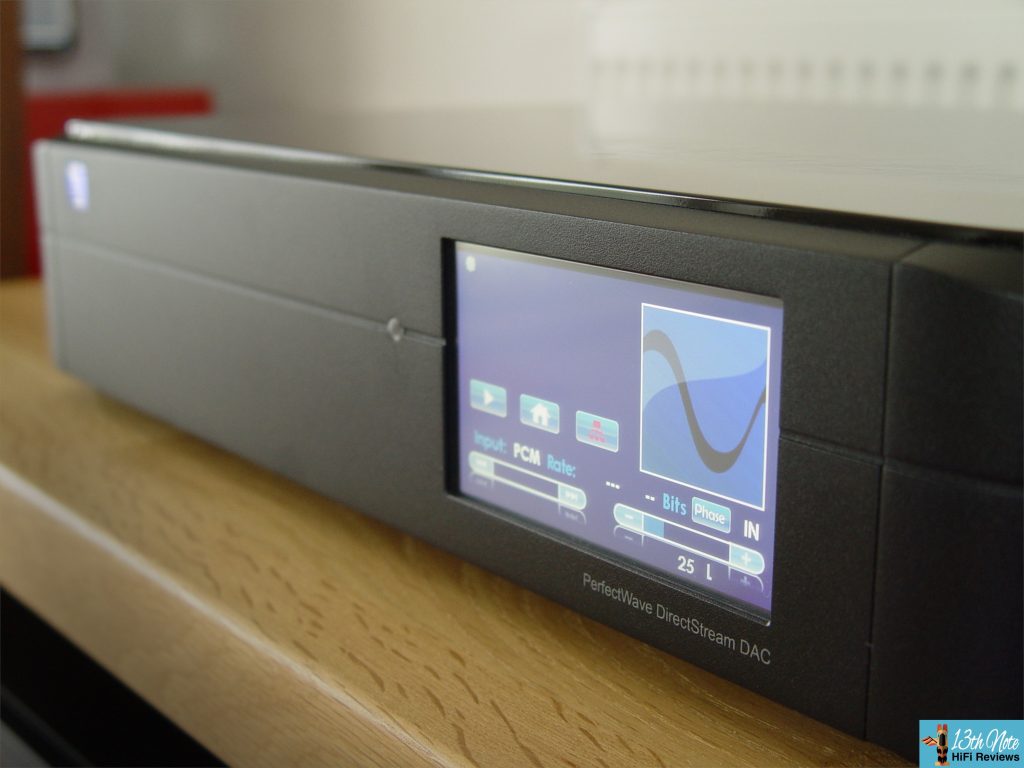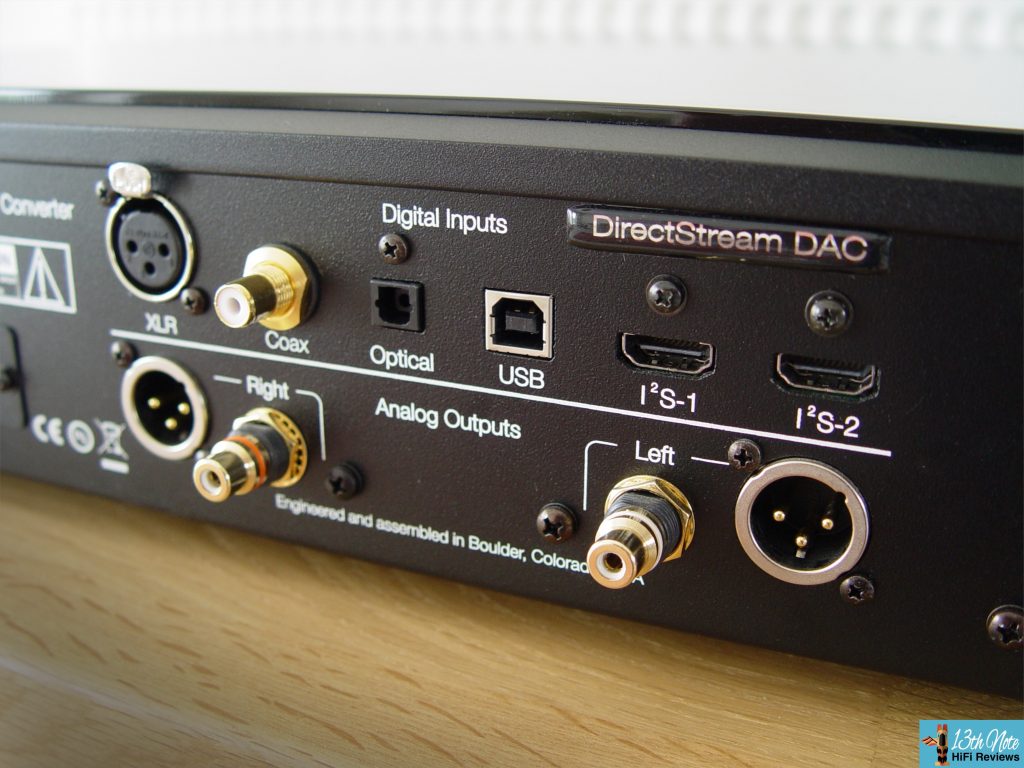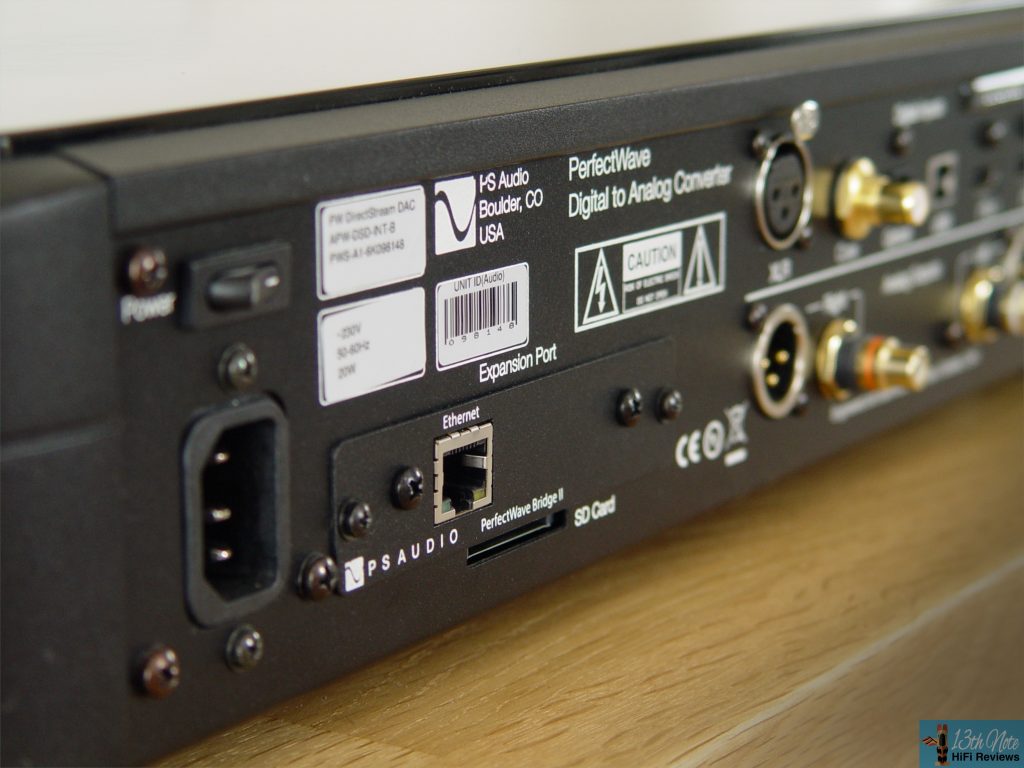From word on the street, my impressions of PS Audio DAC products are that they’ve a knack of punching above their weight. Also the use of FPGA DACs which seem to have consistently good performance across those brands who use them. Yeah you’ve probably heard it, but allow a recap of FPGA – a type of DAC which doesn’t come as an off the shelf chip, but one that is programmed by a manufacturer. This allows firmware updates to change the sonic qualities of the DAC. Apt as this article coincides with the free release of ‘Windom’ for the DirectStream DAC on the 2nd October 2019. All named after mountains in the Rockies and hopefully ones that all increase in height!
The simple PC peripheral looking cases seem built for reasons of economies of scale. Nothing to do with Adam Smith and making pins, but sharing HiFi cases across a range cuts down on unit costs. This means you’d hope to enjoy it for what you buy it for most – sonic qualities.
The DirectStream DAC is enclosed in a metal case with plastic sides with a piano black top, a large-ish 3 1/4 inch by 2 inch front touch screen display and on/off button in the form of the left sided PS Audio logo.
The usual suite of digital inputs occupies the back – well you wouldn’t put them on the side, as that would be odd! But single USB, Coaxial, Optical and balanced XLR inputs are all there. As well as what’s called an i2s (said ‘I squared S’) connection – two of them. They are basically HDMI sockets like TVs use, such that the musical data line and clock lines (which control timing of data transfer) are separated. PS Audio say this improves sonics above the original S/PDIF (Sony Philips Digital Interface) coaxial digital connection developed when CD originally came out, where all these lines are inter-mingled. Purportedly this creates issues when you unwrap the lines at the DAC. An HDMI cable, as a multi stranded cable, suits this purpose. Other PS Audio components like the DirectStream Memory Player have i2s outputs to allow compatibility.

The Network Bridge II is an option for adding streaming capabilities via Ethernet connection. Album art is shown in the display which must happen when a SD card is in its slot – for memory purposes alas. You can see it’s an option by the screwed in Ethernet socket containing plate, rear real estate bound.
The DirectStream is not just a DAC using the outputting unbalanced RCA and balanced XLR sockets, to send the analogue music to your pre amplifier or integrated amplifier. You can also use these connections to send the music to your power amps and use the DirectStream as a pre amplifier. The front touchscreen volume is normally set at 100 if using the former installation, although I note that some PS Audio users prefer using slightly lower than 100. Or alternatively used the fixed output in settings. In the latter set up volume is obviously set accordingly with variable output.
The technology behind this DAC is well reported and I won’t flog a proverbial dead horse on explanations. Suffice it to say that it upsamples incoming PCM digital to 10 times the standard DSD rate. For an explanation of PCM and DSD formats, check the basics section of my website as it develops.
Settings wise the DirectStream is very easy to use; settings for volume, phase, gain for matching to power amps, and input, fixed or variable volume, and that’s about it. The display might make you think it will be more complicated than trying to negotiate a Brexit deal with the EU. Thankfully not.

In the process of the review I was given a PS Audio PerfectWave AC5 power cable to hook the DirectStream up to the mains. With hosepipe esque proportions, it’s a heavy duty beast to say the least.
Vinyl lovers dream digital
Checking out small differences with premium DACs can come across as criticising one brand over another. But let’s be clear here, making comparisons is often like comparing Gordon Ramsey versus Michel Roux…. They are both good. It’s a case of analysing finer details. As much as I enjoy fast food, it’s not like comparing a double dog burger from McDonalds against your local Italian here…..Remember the main sonic traits are in bold as always.
I initially used the USB connection from an Innuos Zenith MkII with the DirectStream being recognised as a Roon end point. PS Audio recommend USB connection if not using i2s connections. I also tried the Ethernet connection from an inexpensive NAS (network attached storage drive). Incidentally if you are an ignoramus to streaming check out my basics article here. You can also use the DirectStream as a Roon end point player by Ethernet connection to your router, with a Roon server on the same network.
Starting off with the currently installed “Yale” firmware, admittedly an old firmware version, this DAC really suits those who like rounded tonality in the mid bass. It makes listening very easy on the ear indeed. There is a rich luxury in the sound – an acoustic musicians dream HiFi component. It too has a strong and deep bass that you tend to find in premium DACs above budget musings.

The soundstage hits you like a truck! It’s much wider than the cheaper and rawer Chord Qutest DAC I’ve just taken out with its partnering MCRU linear power supply. A less gorgeous tone with the Qutest. Whilst it’s hard to compare closely competing products when they are not tested one after the other, when sonic traits are obviously memorable – it is possible. I say this because the DirectStream has more width than the Chord Hugo TT2. With the partnering upsampling Chord Hugo M Scaler for the Hugo TT2, I’m not so sure on ‘wide boy’ credentials. But that combination costs $€£ 2-3k more, so unsurprising. Regardless, interesting as to affects on soundstage by upsampling which I found with the Hugo M Scaler too.
But the DirectStream IS competing with DACs like the Chord Hugo TT2. A touch more expensive, but boy it does compete and a bit like Reggie Kray fighting Ronnie Kray, there is no clear winner. Preference wise, a different kettle of fish, but trading the non smearing precise intonation of DACs like Chord for a more relaxing, wider, and refined listen is what the DirectStream is all about. Take your pick…These traits are it’s reputational modus operandi too. The DirectStream will add meat to the bones of thin recordings, the Chord will intonate fast music. So neither product is better than the other, even though I have a firm personal winner which to be frank isn’t really relevant. This review is not self indulgent – it’s for those who read it to make own choices.
On the subject of reviewer credibility, if you think this review is the subjective opinion of one bod, look at what other reviewers are saying….Subjective opinion forming objective consensus. Is it just still one guys opinion then? One reason the DirectStream is regarded very well!

The DirectStream doesn’t reach the zenith of a Chord DAVE in extracting detail as easily as pulled pork from a tender Chinese restaurant dish. Nor too how it represents every layer in music. But to be fair, it’s not voiced or priced in the same league. Neither is analytica to everyone’s taste anyway. Nor for considerations of how pleasing the DirectStream is, at any level!
The DirectStream can make poor quality recordings stand out such is its quality. Playing select tracks from Tidal there was sometimes an edginess to the music on breathing intake, or sibilant sounds. Bizarrely it disappeared after longer periods of listening. I won’t even start to pretend its vanishing could be explained – don’t you know that HiFi equipment and set up is akin to ghostly sorcery anyway?!!
This is a DAC that suits a relaxed style of listening and because great tone is such a huge part of what makes music enjoyable to many, it’s appealing to a vast plethora of music. But with electronic music, whether by virtue of the effects of this lovely tone or otherwise, it’s not quite as fast as something like the Hugo TT2 or even the cheaper Qutest. I’ve used this explanation before as tone has a huge bearing on perceptions of the speed of audio. Over the Qutest I’d have the DirectStream in the atrial trace of a heartbeat for its effects I’ve mentioned. These are not comparable devices at similar prices though.
What is Clear with these characteristics is that the DirectStream is going to hugely appeal to John or Juliette Vinyl, who do things the old way but want a foray into streaming and digital audio. Or anyone who wants a relaxed sound in digital for that matter. Now is a good time with CD on shakey ground with streaming services soldiering on. It’s consequently the dream DAC and streamer for such people – non digital sounding digital!!! Forget the old reckonings of the past about insidious edgy treble in DACs as to why your music must spin round and round. That thinking is now as far away as Earth is to Mars. DACs like the DirectStream change all this! So this appraisal of the PS Audio DirectStream firmly lets you know who it’s for.

I’d point out it is hard for me to test which digital input is best because my best Innuos source only has a USB output and there would be no source continuity. So not much point doing ‘this input or that input’ reckonings.
Amusingly a friend who owns a DirectStream instructed me in an inelaborate manner to ‘update from Yale to Windom immediately!’ I thought what have I done??!! It’s not as if I’m not putting enough effort into getting these reviews right and credible already, to have to rewrite on new sonics? Anyway the means of updating is quite simple with the SD card after downloading online- the manual is clear and easy to follow by the way.
With Windom the sound stage is improved further, it all sounds very spacey and the bass is slightly stronger. It still maintains similar tonal prowess and midrange and bass responsiveness and the characteristics I’ve mentioned with “Yale”. He was right – definitely an immediate thing to do and I’m instructing you now too! I wouldn’t be confident enough to say if soundstage is bigger than the Chord pairing mentioned, without side by side comparison. But if it is similar or bigger, a huge accomplishment for PS Audio. It also gives a sparkle of customisation to use new updates or roll back to previous ones. PS Audio have a dedicated team led by designer Ted Smith, who concentrate fully on these firmware updates throughout the year, and this is a FREE SERVICE. A big selling point, giving a reason to keep interest in the product and everyone likes a tweak. A change is as good as a rest and all that….
As far as comparisons to the previous version called Snowmass check out my article here.
I intend going back to the previous firmware update “Snowmass” and I will provide my comments on the change in a separate post to my website. Watch this space.
PS Audio recommend using it as a pre to keep signal path short, depending on preference of course, if you have an existing pre amp. I found it was a little leaner than my Cyrus pre amp with partnering Cyrus power supply. The DirectStream keeps its signature as before, if being very slightly cleaner in the mids.
The DirectStream’s Network Bridge II works as a UPnP (universal plug and play) device once its hooked up to Ethernet. It must be connected to your router via Ethernet cable and can then receive music via a music containing hard drive on your computer or network. You need to use an appropriate piece of control software on your computer or laptop or an appropriate app on an Android or Apple phone or tablet. I used Audirvana which works well recognising the Network Bridge II.
Whatever is your preference this is one DAC to try at this price. My articles aren’t selling you anything but help with the white flat thing and long thin thing, for a shortlist. So get out there and try!
Manufacturer details
Contact : support@psaudio.com
Website : https://www.psaudio.com
Distributed in the UK by Signature Systems ; http://www.signaturesystems.co.uk
Thanks goes to Kevin for the loan unit and my friend Stephen with his opinions on his unit.
Check out UK distributor bargains at ; http://www.signaturesystems.co.uk/distributors-bargains/


Price
- DirectStream DAC – £4830
- With Network Bridge II – £840
- PerfectWave AC5 power cable (2m) £367.50
Specifications
- Dimensions : 14” x 17” x 4” [ 36cm x 43cm x 10cm]
- Weight : 10kg
- Power consumption : 30W
- Digital inputs : I2S(2), Coax, XLR Balanced, TOSLINK, USB, Network Bridge slot
- Sample rates : I2S and USB – 44.1khz to 352.8khz 16bit, 24 bit, DSD 64, DSD 128, toslink – 44.1khz to 96khz 16 bit, 24 bit, XLR and coax – 44.1khz to 192khz 16 bit, 24 bit, DSD64
- Output : RCA/XLR Unbalanced /Balanced (X2)
- Frequency response : 20-20KHz +/- 0.25dB
- Data handling : PCM or DSD
- Sample rate : 44.1kHz, 48.0kHz, 88.2kHz, 96.0kHz, 176.4kHz, 192kHz, 352.8kHz
Equipment used in Test
System : Cyrus DAC XP Signature pre amp with partnering Cyrus PSX-R power supply for Cyrus pre amp, Cyrus Mono X200 Signature power amps, Cyrus cd-t cd transport, Innuos Zenith Mark 2, PMC twenty5 23 speakers. Isotek Aquarius power conditioner. Audioquest and Chord Company cables. Using the Zenith into the DirectStream via USB with Roon and via Ethernet into the Network Bridge II.







